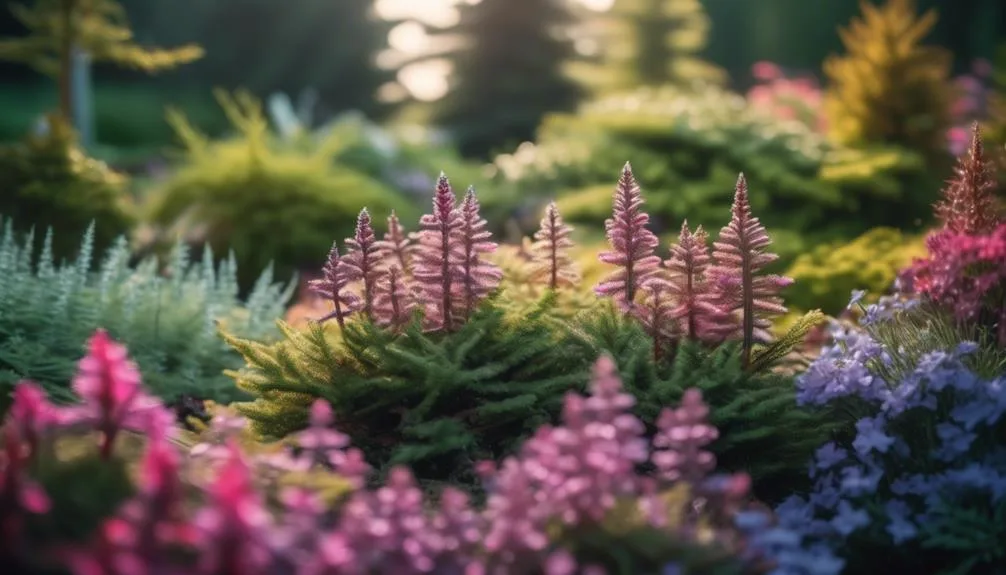Spruce trees are admired for their beauty and are widely planted in North America. Did you know that certain plants can make them even more stunning?
Imagine a garden where every plant complements the grandeur of your spruce trees. In this discussion, find out about the perfect companion plants that will enhance the visual appeal and support the health of your spruce trees.
Flowering Shrubs for Visual Appeal
For a visually stunning landscape around your spruce trees, consider planting flowering shrubs that will add vibrant colors and beautiful blooms throughout the seasons.
Colorful annuals like petunias, marigolds, and impatiens can provide seasonal variety, complementing the evergreen backdrop of the spruce trees. These annuals can be planted around the base of the spruce trees to create a pop of color and bring a refreshing change with each season.
Additionally, climbing vines such as clematis or honeysuckle can be trained to grow up the trunk of the spruce trees, adding vertical interest and a touch of elegance to the overall landscape. These vines not only enhance the visual appeal but also create a harmonious blend with the majestic spruce trees, making your garden a captivating sight throughout the year.
Ground Covers for Soil Protection
To protect the soil around your spruce trees and maintain the visual appeal of your landscape, consider incorporating ground covers that not only offer erosion control but also add a lush and protective layer to the base of the trees.
When selecting ground covers, opt for options that provide moisture retention and weed control, such as pine straw or wood chips. These mulch options not only help in moisture retention but also prevent weed growth, ensuring a healthier environment for your spruce trees.
Additionally, low maintenance ground covers like creeping thyme or moss are ideal for erosion prevention and aesthetic appeal. They create a beautiful carpet of greenery while effectively shielding the soil.
These ground covers require minimal upkeep, making them perfect for enhancing the soil protection around your spruce trees.
Evergreen Perennials for Year-Round Interest
Consider incorporating evergreen perennials for year-round interest in your landscape to add visual appeal and maintain greenery even in the colder months. Some shade-tolerant flowers and foliage contrasts can enhance the beauty of your spruce tree garden. Here are some excellent options for evergreen perennials:
| Evergreen Perennials | Description |
|---|---|
| Hellebore | This shade-tolerant flower blooms in winter, offering early color. Its leathery foliage provides a nice contrast. |
| Bergenia | With large, glossy leaves, this perennial offers year-round interest. In spring, it produces pink or white flowers. |
| Coral Bells | Known for its diverse foliage colors, it thrives in shade and provides a beautiful contrast to spruce trees. |
| Epimedium | This low-growing perennial offers delicate, heart-shaped leaves and dainty flowers, perfect for shaded areas. |
| Japanese Forest Grass | Its cascading, arching foliage adds texture and interest to the base of spruce trees. |
These evergreen perennials can bring vibrancy to your garden throughout the year.
Native Grasses for Natural Complement
Explore the natural beauty and practical benefits of incorporating native grasses as a complement to your spruce trees, adding texture and movement to your landscape. Native grasses not only enhance the visual appeal of your garden but also provide essential ecological benefits.
Consider these options:
- Switchgrass (Panicum virgatum): This tall, graceful grass adds a touch of elegance and movement to your garden. It also provides shelter for small animals and attracts beneficial insects.
- Little Bluestem (Schizachyrium scoparium): This low-maintenance grass offers stunning fall colors and is a favorite among pollinators for its seeds.
- Prairie Dropseed (Sporobolus heterolepis): Known for its delicate texture and pleasant fragrance, this grass creates a beautiful contrast with the sturdy spruce trees.
- Carex pensylvanica (Oak Sedge): This low maintenance sedge forms dense tufts, providing a natural ground cover and an attractive backdrop for pollinator friendly flowers.
Incorporating these native grasses won't only enhance the aesthetic appeal of your garden but also support local ecosystems.
Aromatic Herbs for Pest Management
Enhance your garden's natural pest management while complementing the beauty of your spruce trees by incorporating aromatic herbs known for their ability to repel pests.
Companion planting benefits both your spruce trees and the surrounding plants by creating a natural balance that helps deter pests. Aromatic herbs such as lavender, mint, and rosemary not only add fragrance and beauty to your garden but also act as natural pest repellents.
These herbs release strong scents that mask the smell of host plants, making it difficult for pests to locate them. Additionally, some aromatic herbs, like basil and thyme, contain natural oils that repel insects.
By strategically planting these aromatic herbs around your spruce trees, you can create a more pest-resistant environment that benefits both the trees and the garden as a whole.
Happy gardening with aromatic herbs for gardeners!
Conclusion
In selecting the right companion plants, you can enhance the beauty and health of your spruce trees. Consider visual appeal, soil protection, year-round interest, natural complement, and pest management when making your choices.
By incorporating these elements, you can create a thriving and harmonious ecosystem around your spruce trees.

My interest in trees started when I first saw the giant sequoias in Yosemite.
I was a teenager then, and I remember thinking, “I need to learn more about this.”
That moment stuck with me.
A few years later, I went on to study forestry at Michigan Tech.
Since graduating, I’ve worked in a mix of hands-on tree care and community education.
I’ve spent over ten years helping people understand how to plant, maintain, and protect the trees in their neighborhoods.
I don’t see trees as just part of the landscape.
They are living things that make a real difference in our daily lives.
